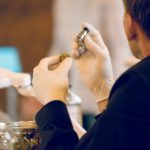
Cannabis has hit the shelves this year, how will you, the consumer, know that you are buying good quality bud? When they present you with a jar of the dried flower what do you look for to tell if the bud is of the best quality?
Being able to inspect and identify quality bud means you will be able to tell the difference between top-shelf and low-grade flower. When inspecting buds it is important to look at them individually without focusing on size as in many cases smaller buds end up being juicer and more potent. You will also be able to recognize signs of contamination or impurities which can be damaging to your health. Unfortunately, the industry is still young and so standards for quality control are not yet in place. This means the more informed you are as a consumer, the safer you will be.
This guide will explain how to look past the surface of big sticky buds and into the working parts that make up the cannabis flower. The process of inspecting for quality is much like how people pick out produce, by touching, smelling, and squeezing to determine if it is ripe for purchase. However, cannabis has a few extra steps, so we consulted with the cannabis community and our industry experts to break down the most popular and trusted methods of inspecting cannabis for quality.
We surveyed the cannabis community via Survey Monkey to determine the top 3 factors to consider when inspecting bud for quality. According to Canadian cannabis patients and connoisseurs the top three signs to check are:
These are all key indicators that can reveal the true quality of a dried cannabis flower. Of course, there are more than three signs to look for. So we combined our industry experiences and the network of experts to put together the B.C. guide to identifying quality cannabis.
The aromatic profile of cannabis is often called “the nose”. Our Cannareps Workshops instructor, Adolfo Gonzalez, consider the nose to be one of the most important qualities to check. However, it can be easily overlooked by casual recreational consumers as cannabis tends to have a very strong odor that is pungent, earthy and intense. Upon the first whiff, the untrained nose may be overwhelmed with the intensity of the smell. But once you start identifying what specific terpenes smell like you will be able to break down the scent profile, much like a sommelier.
Terpenes are major players in the overall entourage effect. Different combinations and ratios of terpenes influence the kind of high you experience. Being able to detect the range of natural scents can help you recognize complex terpene ratios allowing you to pick out the best strains and know if the bud smells like it should, based on the genetics. When the nose is weak, the bud probably will be too.
The nose can reveal signs of chemical use, or poor growing conditions. It is especially important to be able to detect impurities, and many of them have odors of their own. Look out for overly fragrant and synthetic smells that don’t suit the strain. Aromas like soap, perfume, and baby powder might indicate that the grower used fertilizers and didn’t properly flush the plant. However, there are some strains that naturally have a more perfume-esque fragrance, such as Lavender Kush. This is why you want to make sure the smell of the bud aligns with the terpene profile of the strain genetics.
Scents that might reveal mould or contamination include mustiness, urine, and dampness. If the smell seems slightly off or triggers a negative emotional response that could also be a sign that something isn’t right. Inhaling mildew and mould can be very dangerous to your health, if your nose picks up on something that triggers the alarms, it would be wise to listen to it or investigate further.
When people refer to a bud as being “frosty” they are referring to the trichome density. The crystals all over the bud are secretions full of cannabinoids and terpenes. A desirable amount of milky white crystals on the bud is always a great indication of potency and quality. When the bud has properly cured the trichomes (those frosty crystals) will go from clear to white and then to amber as it dries. Since it is impossible to obtain a product with 100% cloudy resin glands, the best case is to have 85% milky trichomes, 10% amber and 5% clear.
Coming in second in our survey, the colour of the ash is a popular way to determine the quality and cleanliness of a bud. Do a burn test to check the ash. Analyzing the remains can provide clues as to how the flower was treated, dried and grown.
When burning the bud check to see if it turns to white or black ash. Black ash can tell you a few things, it could mean there are traces of chemicals, that the bud was not properly flushed, or there might be too much moisture left indicating that it wasn’t properly cured. Checking the ash is popular within the cannabis growing and consumer community.
Upon inhaling, the smoke of good quality bud should feel smooth. If you notice any irregular burning or uncomfortable feeling in the back of your throat this could mean there are traces of chemicals or impurities.
The moisture content of cannabis buds can give you a lot of information about how the bud was cured and stored. Strains that are higher in trichome density may be gummier than others when cured. There is a sweet spot when it comes to the sticky factor, too wet and you know the bud wasn’t properly cured and may be susceptible to mould, it also won’t burn very easily. But then if the bud is too dry, from over-curing or just going stale with time, it will crumble and flake off. At this point, the THC and monoterpenes potency will have degraded due to oxidation which will then change the overall effect.
There are old school growers who have told us that they would test the moisture levels of their bud by squeezing it against a wall and seeing if it would stick. Just like pasta. We don’t recommend you do this, but a gentle squeeze between your fingers can suffice. Look for a springy quality, the bud should bounce back from being squeezed. You should also feel a slight stickiness when breaking it up.
The stronger the terpene profile the more flavourful the taste will be. The presence of fruity or floral notes/terpenes indicates a presence of powerful compounds that can alter the experience (see: entourage effect). You can sometimes detect a subtle taste from just smelling the flower, as the mouth can sense many odor perceptions.
One way to better taste the smoke is to take a hit, hold it, and then breath in and out alternating between your mouth and nose. The smoke will hit many receptors for taste and smell, allowing you to experience a more palpable flavour. Vaporizing will produce the cleanest flavour, while smoke has a more subtle palette. Common popular flavours are fruity, floral, and earthy. Natural aromas and flavours are always signs that the bud is great quality.
Visually inspecting bud involves more than just looking for trichomes, it also means looking for signs of impurities. Things like residue, dirt and hair (we have seen batches that came with dog hair) can appear upon closer inspection and should signal you to find something better.
You can also visually detect more serious contaminants like powdery mildew or spider mites which can be harmful if consumed. The effects of inhaling mouldy cannabis are serious. This makes it crucial that consumers can identify problems just in case the grower missed them. If you ever see patches of white or grey on your bud, do not consume!
Mildew and mould look different than trichomes. Trichomes look like secretions growing out of the plant, anything that looks crystallized, fuzzy, like spider webs or is growing on top of the terpenes is something else!
The density of the bud can reveal certain things about the growing process. While some strains genetically produce looser fluffier buds, density is also generally an indication of a well grown and highly potent flower. Unusually wispy buds can indicate that the plant wasn’t given enough light, wasn’t grown at the best temperature, didn’t get the right amount of nutrients, and a number of other variables.
Take some time to familiarize yourself by doing some research, analyze pictures of buds of specifics strains to know what to look for or what to expect.
A pocket scope can help you take a closer look and examine the trichome density of the bud. A small scope with a 30x magnifying lens will only set you back about $10-20 or so, they can be found online or in many electronic stores. Think of yourself as a fine jeweller who examines each gem with careful consideration before selecting the best stones for jewellery making. Your pocket scope will help you see close up to examine trichome colour and density as well as spot any subtle signs of mould or other contaminants. A trusty tool for any serious consumer or aspiring cannaseur.
The more informed you are as a consumer, the better. Get to know what you like and what to look for. With legalization fast approaching we will no longer have to take the one person’s word about the bud we are buying; they always swear it’s amazing anyway. Now you can tell for yourself. As cannabis becomes more accessible, education and public awareness will too. Stay informed, do your research and take a closer look at the flower you’re buying. If there are any other tips for identifying quality cannabis that we may have missed, feel free to share! The cannabis community is one of sharing knowledge and experiences to further normalization and understanding.
MORE FROM THE BLOG





WAIVER & RELEASE (the “Release”)
This event is conducted by CannaReps Consulting Ltd. (“CannaReps or Company”). Please read and submit below.
I am an attendee at an event hosted by CannaReps (the “Workshop“). I release CannaReps from any and all liability, claims, demands, actions and causes of action whatsoever arising out of or related to any loss, damage or injury, including death, that may be sustained by me while participating in the Workshop.
I understand and agree that:
CONFIDENTIALITY
Any confidential or proprietary information or material relating to the Company’s operations or business which I obtain from the Company or its officers, employees, agents, suppliers or customers or otherwise by virtue of my participation with the Company or by the Company’s predecessor. Confidential or proprietary information or material includes, without limitation, the following types of information or material, both existing and contemplated, regarding the Company or its parent, affiliated or subsidiary companies: corporate information, including contractual licensing arrangements, plans, strategies, tactic, policies, resolutions, patents, trademarks, printed or digitized materials, handouts and brochures. Including any marketing information including sales, investment and product plans, customer lists, strategies, methods, customers, prospects and market research data. Including trade secrets; technical information, including drawings, designs, personal information (the “Confidential Information”).
I understand that the copyright and proprietary interest of any material provided to me belongs to CannaReps. All shared experiences from the Workshop are to remain confidential and private. I agree not to disclose any of the information learned during the Workshop outside of the Workshop except with others who attend the Workshop. I will not use any audio or video recording equipment during the Workshop, unless CannaReps approves of the recording and filming by providing prior written consent. I understand that any audio or video recording made during the Workshop is the property of CannaReps. I will not use CannaReps’ information for business or commercial purposes, without first obtaining the prior written consent of CannaReps.
INTELLECTUAL PROPERTY
I understand, acknowledge and agree that all copyright, trademarks, trade secrets, intellectual property rights, and any other rights arising from any designs, and all of the work products and materials conceived, developed or created by the CannaReps and any rights ancillary thereto (collectively, “Intellectual Property Rights”) which were solely or jointly with others, conceives, designs, creates, derives, develops or makes in the course of or in connection with the work with CannaReps shall belong solely to CannaReps. If you haven’t already, you shall promptly disclose to CannaReps in writing any and all Intellectual Property Rights, conceived, created, derived, developed or made in the course of or otherwise in connection with my participation with CannaReps, whether alone or with others, and whether during work shop hours or through the use of facilities and properties of CannaReps.
INDEMNITY
I agrees to indemnify and hold harmless CannaReps, its officers and directors, employees and its affiliates and their respective successors and assigns and each other person, if any, who controls any thereof, against any loss, liability, claim, damage and expense whatsoever (including, but not limited to, any and all expenses whatsoever reasonably incurred in investigating, preparing or defending against any litigation commenced or threatened or any claim whatsoever) arising out of or based upon any false representation or warranty or breach or failure by me to comply with any covenant or agreement made by me herein or in any other document furnished by me to any of the foregoing in connection with this transaction.
CONSENT
Notwithstanding the immediately preceding paragraph, I consent to and grant CannaReps, the Workshop, and its assignees, the right to photograph and record me, my name, voice, appearance and likeness and other material furnished by me for use on trusted online media which include, but are not limited to, their website and social media pages. My hereby release said matter in perpetuity to CannaReps without prejudice and acknowledge that this consent is freely given without expecting compensation.
By submitting my email address below, I agree to receive electronic communication from CannaReps including personal course information, news, updates and promotions regarding CannaReps’ products. I understand that I can withdraw my consent at any time.
PRIVACY POLICY
Protecting your privacy is important to CannaReps. This Privacy Policy (“Privacy Policy”) set outs the ways in which we use your information and how we ensure its protection.
CannaReps will only collect personal information (“Information”) that will allow us to provide, enhance, market or improve our events and services. Information is collected by means of registration for any CannaReps sponsored event or service. Information collected may include name, age, gender, address, email address, payment information, and geographical information.
CannaReps may share Information. CannaReps retains the right to share Information and other statistics with our partners, prospective advertisers, and other third parties for the purposes of improving, protecting, enhancing, and promoting our events and services. CannaReps may also disclose information to our affiliates, agents, contractors, and service providers in order to facilitate the functioning and maintenance of our events and services. We will not sell any information to advertisers or other third parties.
This Privacy Policy only covers the treatment of Information and other non-identifiable information gathered by CannaReps. This Privacy Policy does not apply to the practices of any third-party services. CannaReps does not take responsibility for the content or privacy policies of any third parties. CannaReps recommends that you review the privacy policies of any third-party service providers or events you access, use, or register for through our events or services.
This Privacy Policy has been established to help you understand our commitment to protecting your privacy. CannaReps reserves the right, at any time, to change or replace any portion of our Privacy Policy. You will be notified of any changes, if we believe, they materially impact your experience at our events or services. Continued use of our services after any change to the Private Policy constitutes an acceptance of those changes.
By submitting this Release and providing Information during the registration process, including the Exhibitor’s Agreement, you consent to the collection and use of your Information for these purposes.
If you have any questions or concerns please email us at info@cannareps.ca.